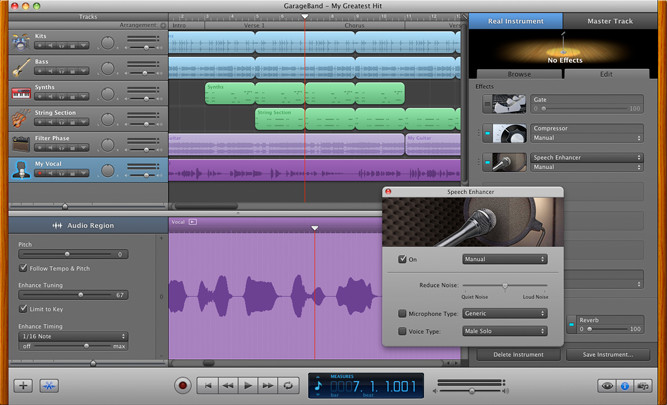
Recording is as simple as arming a track and clicking the Record icon. To the far right, you can launch a Notes page, an audio loop browser, and a media drawer for recorded audio and movies you want to sync music to. It's easy to resize the various windows and zoom levels using the on-screen sliders. The top bar includes icons for triggering the various windows, a transport bar for recording and playback, an LED-style readout for the current beat, bar, tempo, meter, and other information, icons for loop recording, a guitar tuner, a count off, and a metronome. The left side of the display shows your selected instrument. Here you can switch between piano roll and score views, an audio editor, and Smart Controls (more on these later). You click any recorded data to bring up an editor in the bottom portion of the display. The top-right portion of the window is where you add and mix new tracks. Selecting one brings up the main interface. When you first create a project, you're tasked with selecting a template for the kind of music you want to record, as well as an empty project you can populate from scratch. Apple recently gave the interface and underlying code a once-over, with a smoother look and faster performance on Macs with Apple silicon, including M1 Pro and M1 Max processors. I vastly prefer this to GarageBand's old design, which tried to imitate a four-track tabletop recorder.

If you haven't used the app in a long while, GarageBand's basic interface layout mimics Logic Pro and other proper multitrack software. For plugging in an electric guitar or bass, or connecting microphones to record vocals and other acoustic instruments, you'll need an audio interface of some kind, such as the Focusrite Scarlett 2i2 (3rd Gen) or the PreSonus AudioBox USB 96. To use this app, you must plug in a USB-compatible MIDI keyboard and either a pair of headphones or a small pair of desktop speakers. Setup and User Interfaceįor this review, I tested GarageBand 10.4.6 on a 16-inch Apple MacBook Pro (Late 2021, M1 Pro) with 16GB RAM, a 1TB SSD, and macOS Monterey 12.3.1. The fact that GarageBand is free makes the app all the better, and a clear Editors' Choice for entry-level recording software.

Although GarageBand lacks Logic's amazing flexibility, vast array of instruments, and powerful mixing and mastering features, it's almost as powerful when it comes to handling other tasks. Unlike the cartoonish version that debuted in the early aughts, GarageBand features a surprisingly serious presentation that roughly mirrors the high-end Logic Pro digital audio workstation, or DAW. Now, you can do it with the built-in software that comes with every Apple computer, thanks to the free GarageBand. A couple of decades ago, it took a mountain of gear to make an album.


 0 kommentar(er)
0 kommentar(er)
